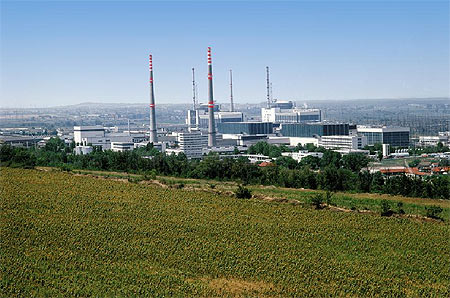
European
Nuclear Society
e-news
Issue 17 Summer 2007
http://www.euronuclear.org/e-news/e-news-17/bulgaria.htm

The Bulgarian Nuclear Society welcomes the fact that all Bulgarian citizens are now citizens of the European Union. To our deepest regret, however, the power of civil society has not proved to be enough to change people’s thinking and our country has paid for its EU membership with the shutting down its most efficient, economically viable and cheapest source of electricity generation – units 1-4 of the Kozloduy NPP.
At the same time, the European Commission proposes to the European Council and the European Parliament a long-term energy strategy, based on significant reductions in greenhouse gas emissions and the more effective use of the energy resources. This is the finalization of a long development process that started with publishing of the Green Book on energy sustainability in the EU. This new strategy, although not advantageous for nuclear energy, recognizes the real benefits it has when it comes to solving energy supply problems.

Kozloduy NPP - units 1-6
The shutdown of Kozloduy’s Units 3 & 4 seriously undermines EU energy policy goals and principles. It also seriously compromises Bulgaria’s national interest. And what’s more, the decision was made for purely bureaucratic reasons.
The following programmes for the modernization of units 1-4 have been carried out:
Period 1991-1996: Cost: 145 million US$; Number of design project changes - 984
Period 1997-1999; Cost: 100 million US$; Number of design project changes - 468
Period 2000-2002; Cost: 66 million US$; Number of design project changes - 375
Period 2003-2005; Cost: 14.3 million €; Systems for severe accident management
Period 2003-2005; Cost: 22.5 million€
Bulgaria is the first country that has an official confirmation from the AQG (Atomic Questions Group of the European Council) that implementing the recommendations were “necessary to achieve and maintain a high level of nuclear safety.”
Kozloduy NPP is the most reviewed and controlled nuclear power station in Europe and probably in the world, as the following timetable shows:
1990 |
IAEA ASSET 1-4 |
1991 |
IAEA SRM 1-4 and IAEA OSART 5 |
1992 |
WANO PERMANENT MISSION 1-4 |
1993 |
IAEA FOLLOW-UP ASSET 1-4 |
1994 |
IAEA ASSET 1-4 and IPERS 5&6 |
1995 |
WANO PEER REVIEW 5&6 and G-24 MISSION, BENCHMARK MISSION |
1996 |
IAEA IPPAS 1-6 |
1997 |
IAEA ASSET 1-6 and IAEA MISSION EMERGENCY PROC. 5&6 |
1998 |
IAEA PRE-OSART 1-4 |
1999 |
IAEA OSART 1- 4; WENRA 1-4 & IAEA MISSION EMERGENCY PROC. 1-4 |
2000 |
IAEA REVIEW 5&6 MODERNIZATION PRG and IAEA REVIEW 3&4 RECONSTRUCT.
PRG |
2001 |
IAEA FOLLOW-UP OSART 1-4 and IAEA REVIEW KNPP ORG. STRUCTURE |
2002 |
IAEA IPPAS 1-6 and IAEA SRM 1 – 4 |
2003 |
WANO PEER REVIEW 3&4 and AQG PEER REVIEW 3&4 |
The conclusions of the safety review teams have always been positive with regard to Kozloduy NPP.
Furthermore, the IAEA Annual Report for 2002 said the following:
"A Safety Review Mission to Kozloduy, in Bulgaria, reviewed the results of more than a decade of safety upgrades and assessments at units 3 and 4, including a series of actions recommended by various IAEA Review Teams.
The Team concluded that operational, seismic and design safety at Kozloduy now corresponds to the level of improvements seen at plants of similar vintage elsewhere.
Many of the safety measures adopted for these plants in the design, operation and seismic areas exceeded those that were foreseen. “
Bearing in mind the reality of the current situation, the Bulgarian Nuclear Society insists that the Bulgarian government take the necessary steps with the European institutions to review this humiliating clause in the agreement reached between the EU and the Bulgarian government. The premature decommissioning of the units 3 and 4 of the Kozloduy NPP was an unwise move and will prove detrimental to the whole EU in view of increased energy demand in the Community.

On 31 December 2006, Kozloduy NPP observed the Bulgarian Council of Ministers decision of 21 December 2006 to shut down units 3 and 4.
![]()
© European Nuclear Society, 2007